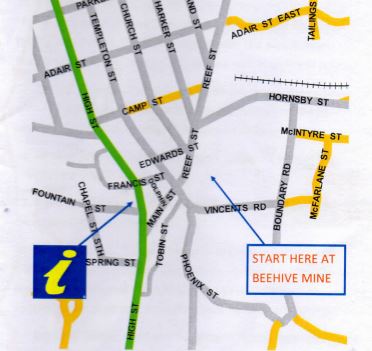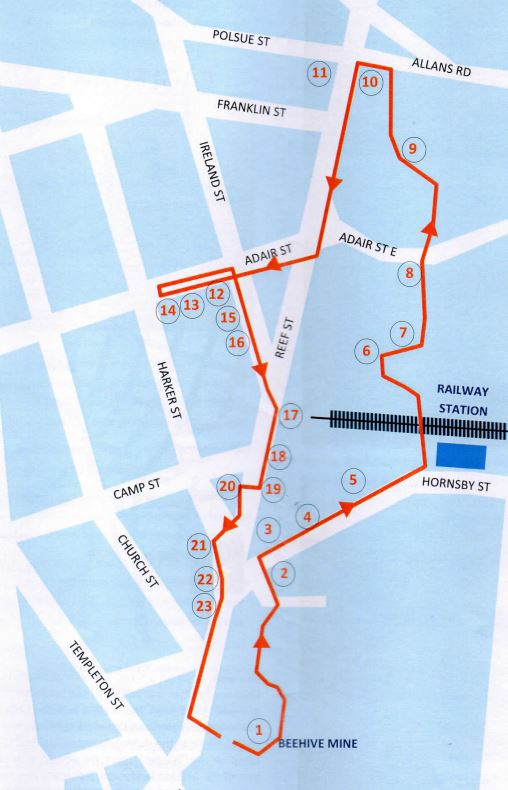Maldon - Eaglehawk Walk

This walk, of about 2.5 km, will take you from the Beehive Chimney to what was known as the settlement of Eaglehawk and back. Eaglehawk was really a suburb of Maldon itself, north of the town. Within and close to Eaglehawk were many alluvial claims, some of the richest deep-reef gold mines and the main camp for the Chinese miners. No wonder it became a thriving part of the Maldon landscape. Not many remnants of this hive of activity remain today. Let's see what we can find!

Eaglehawk Walk Map

1. Beehive Mine. The 24m high chimney for the Beehive Mine was built in 1863. Designed by local architect David Drape, it served the boilers which provided steam for the mine engines. This mine continued operating until after World War 1. In 1923, when the rest of the buildings and equipment were auctioned, two local benefactors bought the chimney for 22 pounds to preserve it as a memorial to the miners.
Follow the track from the Chimney in a northerly direction through the Beehive Mine ruins until you reach Hornsby Street (Bendigo Road), where it leaves Reef Street. Turn right along Hornsby Street, carefully crossing over to the footpath.
2. 2, 4, 5, 7 and 9 Hornsby Street. A group of attractive houses and cottages that go back to the period 1860-1900.
3.1 Hornsby Street. The mining surveyor Robert Nankivell owned this property in the early days of gold mining in Maldon. He was a prominent member of the early Maldon community.
4. 3 Hornsby Street. James Dabb, the poor younger brother of the rich merchant Samuel Dabb, lived here with his family after moving from 9 Adair St. (see pt.14). Moving to Hornsby Street was considered rather a comedown from the more salubrious Adair Street!
5. 11 Hornsby Street. This little cottage built right on the street was a shop in its early days. Around 1908, Daniel Aust, a fruiterer, owned the property. The shop probably sold fruit to railway passengers.
Turn left and cross the railway line between the engine shed and the station building, beside the stationary tank engine. Follow the path over the tracks and beyond.
6. Somewhere near here was the Welsh Swagman's Cottage. Known as "North Railway Gate Lodge", this small brick building is no longer visible. It is described by Joseph Jenkins in his diaries as being close to a pedestrian gate and is believed to have been near the Alliance mine. Joseph Jenkins' story is a fascinating one to explore in greater depth in the book "Diary of a Welsh Swagman" (unfortunately now out of print).
7. Alliance Mine. Situated on the Eaglehawk Reef, where deep reef mining began in Maldon. By 1886 it was one of the richest mines on the field. The Alliance shaft near the Government Battery was eventually connected underground to the Eaglehawk Associated shaft about a kilometre to the north, near Allans Road. On September 9, 1895, the steam boiler at the Alliance battery exploded with a deafening roar, raining fragments of iron far and wide. Mine accidents like this occurred often.
8. State Government Battery. This was built in 1914 and operated until 1989. Before this, many mines had their own batteries of stamping machines to crush the quartz. In the 1850s, the Edwards brothers ran a crushing plant in Francis Street, where the Community Centre is now. They claimed to be one of the cheapest places to crush your quartz.
Cross Adair Street East and follow the gravel track through the reclaimed land.
9. Eaglehawk Pit. This whole area was the scene of feverish deep-reef mining activity prior to 1900.
Come out onto Allans Road and turn left towards what is now the 'The Eaglehawk Country House Hotel' on Reef Street. This was formerly the Eaglehawk Hotel. Reef Street was originally called Eaglehawk Road and the vicinity of the Hotel was a thriving commercial centre.
10. Public Baths, once opposite the Eaglehawk Hotel. The Tarrangower Bathing Company, with Frederic Courtin as chairman, operated the Baths from 1860. Water from the nearby Eaglehawk mine was used to fill a large rectangular pool which measured 90 feet by 60 feet and 3-6 feet deep. It had a special enclosure for "females"!
11. 35A Reef Street, the Eaglehawk Country House Hotel. This site has been used as a hotel since 1854 and is close to the Eaglehawk Gully diggings, just across Allans Road. Owned by Frederick Courtin from 1862, the original hotel with 11 bedrooms, bagatelle room and concert hall, burnt down in 1906, after which the existing building was constructed. Mr. Courtin was a prominent Maldon citizen, particularly in the German community, which dominated Eaglehawk. He was a member of the first Maldon Shire Council.
Follow Reef Street back towards the town.
To be found here in Eaglehawk were doctors, lawyers, chemists, hotels, churches, school, a Jewish synagogue and numerous small shops. The Eaglehawk Motel was originally J. Crisp's butcher's shop. In the 1860s, the Victoria Hotel would have been found in the middle of the Reef Street-Adair Street intersection. Eaglehawk Road was later realigned and renamed Reef Street and the hotel became the Railway Hotel in 1884.
Turn right into Adair Street to the first intersection with Ireland Street.
12. 3 and 5 Adair Street. These relatively recent houses mark the site of the German Club and Gymnasium. The buildings, on land owned by Mr Courtin, were a focal point for the German community of Eaglehawk.
13. 7 Adair Street. Now called "Ellamatta". It is a well preserved Victorian house, originally owned by J. Ransom.
14. 9 Adair Street. Now known as "Belmont". Originally owned by T. C. Cooper, this house later belonged to James Dabb. His more prosperous older brother Samuel, owner of Dabb's Stores, lived diagonally across the road at "Mt Hawke" (24 Adair Street). It is a large, gracious house which boasts a ballroom.
Retrace your steps back along Adair Street and turn right into Ireland Street.
15. 11 Ireland Street. Now known as "Kookaburra Cottage", originally owned by J. Stebben.
16. 9 Ireland Street. Originally called "Rosebank", this is now "Fairbank House". It was built around 1895 for the Berryman family; first Arthur, then his brother John, the well-known Maldon boot maker. Ireland Street runs into Reef Street again.
17. 12 Reef Street. On the east side of the street and backing onto Railway land, it is likely that this house was a railway residence, probably occupied by the stationmaster.
18. 10 Reef Street. "Leach's Cottage", originally owned by Joseph Leach from 1865.
19. 8 and 6 Reef Street. Two more charming cottages, also owned by the Leach family.
20. 13 Reef Street. This is a Victorian house on a triangular allotment on the corner of Camp Street. It was a school at some stage. This location is thought to have been Cullen's Dam, a puddling dam used as a swimming hole by the early miners.
21. 1 Harker Street. "Morgan's Cottage". It was here that an ice works operated in the 1950s, before refrigerators became widespread in homes. Ice was made in the extensive sheds behind the house. Like several other homes in Maldon, this cottage has a mineshaft under one of its rooms.
22. 11 Reef Street. Now called "Witbank", the garden of this charming house boasts a palm tree, once a fashionable addition to front gardens.
23. 9 Reef Street. Called "Smith's Cottage", of which there is at least one other of this name in Maldon. A typical miner's cottage from the early days.
Return to the Beehive Chimney, having re-lived a little of life in and around Eaglehawk in its heyday.
Location
Bendigo-Maldon Road, Maldon 3463 View Map








